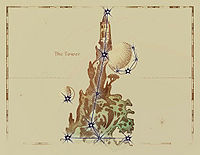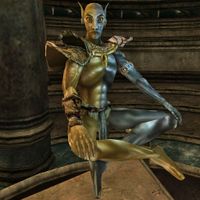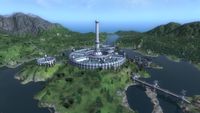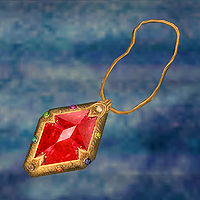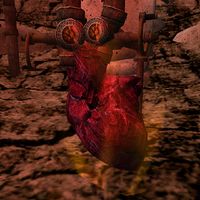Utilizador:Minor Edits/Sandbox4
| Posted here. |
- "Well, some think that the White-Gold Tower—and some other towers around Tamriel—help, well, hold the world up, or something like that. Others believe that before the Dragon broke, the tower helped protect us from invasion from Oblivion [...] They help keep Mundus—the World—from dissolving back into Oblivion. Or something like that. Anyway, everyone seems to agree it has power, but no one knows exactly what kind." — Prince Attrebus Mede, The Infernal City
To understand the Towers, one must first distinguish them from the Tower. The Tower is not to be confused with the constellation of the Tower, though the constellation is a representation of it. The Tower is an esoteric metaphysical conceptualization of the universe, a proper understanding of which can be utilized in achieving unimaginable power. As such, it is also unimaginably dangerous. The Tower is the existence of one's true self within the self of the universe. It is a metaphorical absolute, being both an idea and a tangible reality at once. It predates the creation of Mundus, though its influence has echoed throughout the mortal realm. The Thief, which is likewise both a constellation and a metaphorical absolute, acts as protector of the Tower. The Thief represents the taking of the Tower and its secret.
Índice
The Tower
- "The Tower touches all the mantles of Heaven [...] and by its apex one can be as he will. More: be as he was and yet changed for all else on that path for those that walk after. This is the third key of Nu-mantia and the secret of how mortals become makers, and makers back to mortals. The Bones of the Wheel need their flesh, and that is mankind's heirloom." — Commentaries on the Mysterium Xarxes, Book Three
Long ago, after watching the Aurbis reshape itself many times, Lorkhan grew bored and left it behind. He traveled beyond the Wheel, into the Void. There, he looked back and saw what the Wheel had created. Looking at a wheel sideways reveals an "I", and this is what Lorkhan saw. The "I" is the Tower.
The Wheel
- Look at the majesty sideways and all you see is the Tower, which our ancestors made idols from. Look at its center and all you see is the begotten hole, second serpent, womb-ready for the Right Reaching, exact and without enchantment. — 36 Lessons of Vivec, Sermon 21
The Wheel is the structure of the Aurbis. The Spokes are "eight components of chaos", believed to be referring to the Divines and the primordial force of Padomay. They are the "lent bones" (i.e. Earth Bones) of the Aedra, those who formed the earth upon which mortals tread and gave them the blending of the primordial forces of Anu and Padomay: static change. Outside the spokes is the Aurbis, though this is probably better understood in context as Aetherius, the spirit realm, the rim of the Wheel.
The spaces between the Spokes are Oblivion, the realms of the Daedric Princes. Mundus is the hub.
The Secret
- The heart of the second serpent holds the secret triangular gate. [...] Look at the secret triangular gate sideways and you see the secret Tower. [...] The secret Tower within the Tower is the shape of the only name of God, I. — 36 Lessons of Vivec, Sermon 21
Those trying to find the Tower are seeking to follow Lorkhan's path, to see the "I", except without leaving the Wheel. They are seeking to comprehend wholly and completely the nature of all and their place within, while still being able to comprehend and express their own individuality. If successful, they are said to dance atop (or reside within) the Tower, observing it without fear, which is to know CHIM. But all who dance atop the Tower change forever the path for those who come after.
However, Mundus is the hub of the Wheel, the heart of all creation. Its secret is that this hub is "the reflection of its creators, the circle within the circle". A microcosm allowing one to perceive the Tower without leaving the Aurbis, making it much easier to see. Those who can stand in this flux of reality yet remain whole of mind may look at it sideways and see the “I”. This is the secret Tower. Those who reach a true understanding on the nature of the universe, the nature of the Tower, are sometimes said to know a "Right Reaching". Vivec also wrote of the "secret triangular gate" of the Heart of Lorkhan through which mortals could perceive the secret Tower.
Those who take a favorable view of the creation of the mortal plane assert that Lorkhan came up with this idea so that others could find what he did. As all know, Lorkhan's motivations for this have been heavily disputed throughout history. All agree that he failed, but some assert that he sabotaged his experiment with the Tower intentionally so that others would know how to avoid doing so.
The Towers
- "The Aldmeri or Merethic Elves were singular of purpose only so long as it took them to realize that other Towers, with their own Stones, could tell different stories [...]" — Aurbic Enigma 4: The Elden Tree
The Towers of history are both natural and artificial "polydox constructs" which dominate various regions of Tamriel. They are magical and physical echoes of Ada-Mantia which are believed to strengthen and reinforce the strictures of Mundus. The Towers' relation to the metaphysical Tower is unclear, but presumably, understanding both is necessary to understand either.
During the Merethic Era, the Aldmeri devised a way for "Variorum Architects" to inscribe rules for new Towers. They self-refracted, with different bands following different Towers and Stones, resulting in the proliferation of the Towers which are known today. According to legend, while time was linear in the Merethic Era, it was not singular: by building their own Tower, each group could create their own narrative, parallel but distinct to those around it. And so, the Towers did their Dance, and each one took a "myth-form". However, much of their respective histories is said to be muddled by lies and misinterpretations. Some Towers are meticulously crafted reflections of Ada-Mantia, while others have followed a more unique path. Some, though echoes of Ada-Mantia, are considered refutations of that Tower, at least one (Walk-Brass) to such a great degree that it apparently refuted itself into nonexistence.
Every Tower has its Stone. They are magical and physical echoes of Ada-Mantia's Zero Stone, by which a Tower might focus its energy to mold creation. While Aetherius is the source of "creatia", accessing the spirit realm is difficult and requires great expenditures. Therefore, the general rule is that Stones cultivate creatia indirectly, borrowing surplus creatia which has washed into Oblivion from Aetherius. The Stones then graft this creatia to the terrestrial domain of their respective Towers.
In various times and ways throughout history, the connection between a Stone and its Tower has become compromised, apparently resulting in the deactivation of whatever protection that Tower had afforded Mundus. The deactivation of a Tower is believed to pose the greatest possible threat to the very existence of the mortal realm. As such, mystics can become alarmed at mere interest in the subject among the common folk. It should be kept in mind that the designations below ("Ayleid", "Dwemer", etc.) are metaphysical and conceptual in nature, as no race is of a single shared mind. The Towers are first and foremost metaphysical concepts, and the constructs representing them are mere physical echoes. Below are the most well-known of the Towers, though it is possible others may exist. And in some instances, a Tower's physical avatar within Mundus has been inferred.
Ada-Mantia
- "[A]s the world congealed into reality, the Gods made a great tower to discuss how best to proceed with the making of Mundus. The physical, temporal, spiritual, and magical elements of Nirn were set at this Convention, and the tower itself remained behind even as some of the Gods disappeared into Aetherius. Today it is the Adamantine Tower on the little island of Balfiera between High Rock and Hammerfell in the Iliac Bay. That such a humanoid structure remains the sole footprint of the Aedra speaks perhaps of the essentially mortal nature of our world." — Pocket Guide to the Empire, Third Edition
Tower Zero. Adamantine. Direnni. The Ur-Tower. The tower on the Isle of Balfiera is known by many names. It was the first unassailable spike of reality in the Dawn, the site of Convention, the single oldest building in all the known world. Legend holds that linear time began around the tower, which defined reality within its Aurbic vicinity, and spread from there in a stepped fashion. It was this tower which would be emulated across Tamriel. Architects have noted that building a tower to its proportions should not be possible.
Ada-Mantia's Stone is the Zero Stone, which is still within the Foundation Vault of the tower. It is undoubtedly filled with immense power, but has remained inert and immutable throughout history despite attempts by some of the greatest mages in history to unravel its secrets. It was through this Stone that the powers of Ada-Mantia at Convention determined the spread of creation and their parts in it.
Convention consisted of two known decisions: the punishment of Lorkhan, and the decision of Aedra to either leave Mundus or stay and become the Earth Bones. The "First Tower Dictate" is said to be "render the mutant bound where he may do no more harm. As God of the Mundus, alike shall be his progeny, split from their divine sparks. We are Eight time eight Exarchs. Let the home of Padomay see us as sole exit". At the apex of Ada-Mantia is where Auri-El is said to have slain Lorkhan, impaled his Heart on an arrow, and launched it across the world. Even after the Aedra left, Ada-Mantia continued to dictate reality in its vicinity, bringing unrelenting order to the chaos of the Dawn.
The facade has changed over the years, but the core of the tower has remained entirely the same: a single great, seamless, impregnable spire of ageless metal which is at least half-embedded in the ground. It is entirely smooth, except for one point known as the Argent Aperture which is thought to be a door. Adjacent to the Zero Stone, this door has a lock of thirteen slowly counter-rotating rings. It has never been opened.
Red Tower
- "The vast Volcano of Tamriel, this giant mountain dominates the north of Morrowind. It is a small continent all to itself, riven from the rest of Morrowind by the remains of a colossal crater [...] Legend attributes its birth to the fall of a god to earth [...]" — Pocket Guide to the Empire, First Edition
When the Merethic elves self-refracted, the Chimer followed Red-Heart. When the Heart of Lorkhan fell to the ground in modern-day Morrowind, the Red Tower rose around it, the second of the Towers whose creation can be directly attributed to the Aedra themselves. This volcano is known to most as the Red Mountain (and the surrounding area).
Auri-El launched the Heart of Lorkhan across the world because he could not destroy it. It is the Heart of the World, and merely laughed at his efforts. As the Aedra sought to leave the world for its own good at Convention, the raw power of the Heart was essential in order for the world to survive in their absence. Thus, the Heart became the First Stone to the second Tower. It imbued Mundus with a special kind of divinity: NIRN ("the Grey Maybe" in the language of the Ehlnofey), the consequence of variable fate. The Dwemer found the Heart buried deep beneath the mountain, and High Craftlord Kagrenac sought to harness its power in the building a mechanical god for the Dwemer. But that is the story of the Tower of Walk-Brass.
Using Kagrenac's achievements, four Chimer eventually tapped into the power of the Heart: the Tribunal of Almalexia, Sotha Sil, and Vivec wielded the divine power of the Heart for thousands of years for the benefit of their people. But when their former compatriot, Dagoth Ur, awoke beneath the mountain circa 2E 882, they became locked in a bitter stalemate with him, and they found themselves unwilling, unable, to do what they needed to in order to win. And eventually, they lost the capability of winning, and instead began losing, slowly.
However, with the fulfillment of the Nerevarine Prophecies in 3E 427, Kagrenac's bindings upon the Heart were destroyed: the Heart of the World was set free. All who had stolen power from it lost their divine spark, and the threat Dagoth Ur posed to Tamriel was quickly eliminated. Unfortunately, this meant that the Red Tower no longer had its Stone. The Red Tower had fallen, and some worried that this cost would be too great to bear, for the barrier between Mundus and Oblivion was rendered weaker than ever before, and great enemies who had long coveted the mortal plane decided to act upon their avarice.
White-Gold
- "But of all the Prismatic Mer, none were more presumptuous than the Ayleids of the Heartland. They built their tower in open emulation of Ada-Mantia, using as Founding-Stone the great red diamond they had uncovered: Chim-el-Adabal [...]" — Aurbic Enigma 4: The Elden Tree
The Ayleids built their White Gold Tower to reflect Tower Zero, Ada-Mantia, and used the Chim-el-Adabal as their Stone, as it was purportedly the crystallized blood from the Heart of Lorkhan which fell to the ground as the Heart sailed over the Heartlands. Through their powerful machinations, their tower of White-Gold became Tower One (though history records that Crystal-Like-Law was erected before the White Gold Tower). It has also been called simply the White Tower. The Ayleids' purpose in building their Tower was to counteract the spiritual bleeding from Mundus caused by the Convention at Ada-Mantia, to make a focus point for reuniting the mortal realm with the divine. To this end, they entered into a pact with the Daedric Princes to harvest castaway creatia from the Void.
It is noteworthy that the Ayleids built more than a just the central tower: with eight lesser towers forming a ring around White-Gold, the Ayleids had built their own Wheel, which apparently gave the Tower of White-Gold a power over creatia unlike any other Tower. This special power also made White-Gold especially dangerous, for if the Ayleids succeeded in making their own Wheel, their own microcosm with a microcosm, then if and when it was meddled with, the consequences could prove absolutely disastrous.
In 1E 243, the Alessian Slave Rebellion came to a head, and the armies of man, led by Morihaus, took the White Gold Tower. Though the Ayleids lost their Tower, it did not fall. Rather, the legend of Saint Alessia and her new Covenant with Akatosh began. It is said that her rebellion was blessed by Akatosh, who looked with pity upon the plight of her people. He drew his own blood and blessed Alessia with it, forging their pact: so long as Alessia's generations were true to the dragon blood, Akatosh would endeavor to seal tight the Gates of Oblivion and deny the armies of Daedra and undead to their enemies. In token of this Covenant, Akatosh gave to Alessia and her descendants the Amulet of Kings (whose centerpiece was the Chim-el Adabal), as well as the Dragonfires of the Imperial City. So long as the Empire maintained its worship of Akatosh and his kin, and so long as Alessia's heirs bore the Amulet of Kings, Akatosh and his divine kin would maintain a strong barrier protecting the mortal plane.
Mortals did not always prove capable of holding to this Covenant. During the Interregnum of the Second Era, and again during the Oblivion Crisis, the Amulet of Kings had no master, with devastating results for all of Tamriel. But at the end of the Oblivion Crisis, Martin Septim forged a new agreement between mortals and the gods, again written in blood — this time, his own. As Mehrunes Dagon and his armies rained devastation down upon the Imperial City, Martin shattered the Amulet of Kings, transforming himself into an avatar of Akatosh and vanquishing Dagon, jettisoning the Prince of Destruction back into Oblivion. With the Amulet gone, the Dragonfires quenched, and the last Dragonblood Emperor dead, the barrier to Oblivion is sealed forever. With the cost of his own life, Martin ensured that never again will the Daedric Princes be able to enter the mortal plane en masse.
It was a miraculous victory for all mortalkind, and perhaps the true significance of this victory is still not fully understood. But nevertheless, Tower One was left without a Stone. Like Red Tower, White-Gold was apparently left defunct. Further, this would not be the only Tower to fall to Dagon's onslaught.
Crystal-Like-Law
- "I stood transfixed as the heart of my homeland was torn as if from my own breast. The unthinkable, the incomprehensible... the tower of Crystal-Like-Law cast to the ground, with all the dignity of a beggar meeting an iron-clad fist. An eternity I watched, trying to reconcile what I knew with what I saw." — Rising Threat
The Crystal Tower was one of, if not the very first, tower which was erected in emulation of Ada-Mantia. In erecting Crystal-Like-Law, the elves of Summerset Isle sought to focus on "dracochrysalis", or keeping elder magic bound before it could change into something lesser (and act which, ironically, required aetherial surplus).
The white interior of the tower was said to radiate light. Little is known of the Stone of Crystal-Like-Law, but it is said to have been a person. For the people of Summerset, the tower was the heart of their homeland, a heart which was ripped out during the Oblivion Crisis. Before Martin Septim could close shut the jaws of Oblivion, the hordes of Daedra attacking the homeland of the Altmer were able to use magic to topple their tower. Crystal-Like-Law had fallen. However, appearances may be deceiving, for this bastion of sorcery seemingly transcended normal conceptions, existing in many planes other than Mundus.
Snow Throat
Snow Throat, or the Snow Tower, is represented in the Throat of the World. Its apex is said to be only "half here". Its Stone is thought to be a cave.
"The Prophecy of the Dragonborn", which is usually attributed to the Elder Scrolls (though it's sometimes called an Akaviri prophecy), mentions the Snow Tower, along with several other Towers:
- When misrule takes its place at the eight corners of the world
- When the Brass Tower walks and Time is reshaped
- When the thrice-blessed fail and the Red Tower trembles
- When the Dragonborn Ruler loses his throne, and the White Tower falls
- When the Snow Tower lies sundered, kingless, bleeding
- The World-Eater wakes, and the Wheel turns upon the Last Dragonborn.
The Prophecy's reference to the Snow Tower has been widely construed as referring to the plight of Skyrim during the Stormcloak Rebellion, wherein High King Torygg was killed and the province was launched into a bitter civil war. Thus, the Prophecy helps illustrate that a Tower is far more than the physical echo associated with it. For it was not the Throat of the World which was left sundered, kingless, and bleeding. That was the Nordic people.
Green-Sap
- "All things to the Tree
- From the Tree, all things" — Ayleid prophecy
The Bosmer did not build a Tower, they grew it, a great graht-oak whose roots sprang from a Perchance Acorn. This was their Stone. And because the Acorn might perchance have been elsewhere, thus was Green-Sap manifold and several. And each could walk, and sing their own songs. From the interplay of the manifold Green-Sap, the Bosmer learned the songs which "made the trees dance", and which dances they desired to perform. In other words, each Green-Sap was able to tell sing their own song, tell their own story — create their own reality. And the Bosmer took joy in this, and in picking the song which appealed to them, as it was a reflection of their own nature.
Each Green-Sap was also every Green-Sap. Within each were told all the stories of the Green, with every ending true, though none any truer than another. When the Alessian Slave Rebellion caused Ayleids to flee Cyrodiil, a great amount of them were welcomed by the Bosmer of Valenwood, so long as their cousins agreed not to dissonate the greensong of Green-Sap. All agreed to this, save the arch-mage Anumaril.
Before the taking of the White Gold Tower by Morihaus during the Alessian Slave Rebellion in 1E 243, Anumaril "fangled" a Staff of Towers, which was composed of eight segments, each one a semblance of a Tower in its Dance. White-Gold Knights took seven of these segments and carried them off to hide them in distant Fold-Places. Anumaril left with the eighth, disguised as a femur - this was Segment One, a semblance of Tower One, and thus also a reflection of Tower Zero.
When Anumaril fled to Valenwood, he still carried with him Segment One. He asked the Great Camoran to show him Green-Sap, and was brought to one that by happenstance stood then in Elden Root. There, he found a Perchance Acorn. To this golden nut, Anumaril showed the segment. For the first time, the greensong knew only one ending. And so, that ending became definite, and the Perchance Acorn became a Definite Acorn. Accordingly, the Bosmer's Tower became definite, as well: the Elden Tree, also called the First Tree, or the Great Tree, which is found in the Elden Grove. Life itself seems to be stronger around it, and it is believed by many to be the tree that seeded all of Valenwood.
Due to Anumaril's fanglement, the Elden Tree would not walk again. Using his dentition as tonal instruments, Anumaril dismantled his bones and built of them a Mundus-machine that mirrored Nirn and its planets. And when he had used all his substance in fangling this orrery, the Orrery of Elden Root, he placed the segment-sceptre within, hiding it between the Moons. Through these efforts, he had hoped to convert Green-Sap into White-Gold, and thereby remake the Ayleids' realm. But Anumaril's plan went awry for reasons he could not have anticipated. His Ayleid magic was concerned with "Will, and Shall, and Must—but under Green-Sap, all is Perchance".
According to legend, if any person stepped into the center of this orrery when it was activated, it would reveal their inner self. Prince Naemon, younger brother to Queen Ayrenn of the Aldmeri Dominion, learned this lesson well shortly before his death circa 2E 582. After betraying his sister and entering the orrery, he briefly glimpsed a vision of the White Gold Tower, and then found himself painfully transformed into some sort of monstrous ogre. He flew into a rage and was quickly killed.
Anumaril's plan did not necessarily fail, as his machinations presumably continue. So, while the ending to the story of Green-Sap is determined, that ending still remains a mystery. For some Towers, though, their ending has already come and gone, but the mystery remains.
Orichalc
Orichalc is one of the most mysterious of the Towers; little is known beyond the name. Some Redguards venerate Diagna, the "Orichalc God of the Sideways Blade", an avatar of the HoonDing which managed to "achieve permanence" and thus entered into the pantheon of the Crowns. The Stone of Orichalc was a sword. It is suspected that Orichalc was found in Yokuda, and may have been related to the Lefthanded Elves. With Yokuda evidently gone, this Tower is most likely gone, as well.
Walk-Brass
In Walk-Brass, also called the Brass Tower and the Brass God, the Dwemer sought to make their own god. Their ambulatory, usually anthropomorphic Tower is better known to most as Anumidium, the Prime Gestalt, the divine skin. The book Divine Metaphysics is an explanation of how the Dwemer planned to make this new god using Kagrenac's tools and the sacred tones on the Heart of Lorkhan.
It is thought that Anumidium was meant to be used many times to transcend Nirn. High Craftlord Kagrenac conceived its construction, which required that Dwemer sacrifice their souls to create its body, with the intention of leading them to transcendence and salvation. Kagrenac's plan was famously interrupted by Dagoth Ur's discovery of his intentions, which led to the Battle of Red Mountain circa 1E 700 wherein all Dwemer on Nirn disappeared. Misuse of the golem they left behind (which, historically, has proven to be every known use) is believed to have terrible long-term metaphysical consequences.
Pieces of the golem, called Numidium, fell into the hands of the Tribunal, who eventually traded them to Tiber Septim as part of their Armistice with the latter's Empire in 2E 896. In the town of Rimmen in Elsweyr, Anumidium was slowly reassembled and finally activated. Though it was meant to be infused with the Heart of Lorkhan, Tiber's Battlemage Zurin Arctus devised a way to create the Mantella to function as the Numidium's heart. This was a mere copy of Anumidium and not as effective, but Tiber was still able to conquer the whole continent, becoming the first Emperor of Tamriel and ending the Second Era. This copy was used again in 3E 417 to bring about the Miracle of Peace in the Iliac Bay region, but it was apparently destroyed in the process.
These successes served as inspiration for a new golem, known as Akulakhan or the Second Numidium, which Dagoth Ur was building beneath Red Mountain as part of his plan to drive the foreigners out of Morrowind and then conquer Tamriel. Like Anumidium, Akulakhan was to be powered by the Heart of Lorkhan. It was destroyed by the Nerevarine in 3E 427 when he freed the Heart from Kagrenac's bindings.
Gallery
Notes
- When asked about the Stone of Falinesti, Michael Kirkbride said it was "a fruit".
See Also
- 36 Lessons of Vivec, Sermon 21
- The Amulet of Kings
- Aurbic Enigma 4: The Elden Tree
- The Book of the Dragonborn
- Mythic Dawn Commentaries 3
- Tower of Adamant
References
Nota: as seguintes referências não são encontradas no jogo. Elas são incluídas para providenciar um fundo mais sólido ao artigo, mas podem não refletir lore estabelecida.
External Links
- Nu-Mantia Intercept, The Imperial Library
- Vehk's Teaching, The Imperial Library
